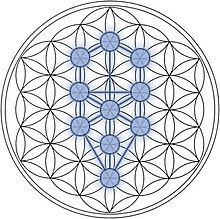From Wikipedia, the free encyclopedia/Blog Ref http://www.p2pfoundation.net/Multi-Dimensional_Science
For other uses, see Flower of Life (disambiguation).

Geometrical symbols, including a "flower of life" rosette, incised on roof beams of a ceiling dating from 1681, Rural Architecture Museum of Sanok, Poland. Such marks were thought to provide protection from lightning.
A "Flower of Life" figure consists of seven or more overlapping circles,[1] in which the center of each circle is on the circumference of up to six surrounding circles of the same diameter. However, the surrounding circles need not be clearly or completely drawn; in fact, some ancient symbols that are claimed as examples of the Flower of Life contain only a single circle or hexagon.
Drunvalo Melchizedek has called these figures symbols of sacred geometry, asserting that they represent ancient spiritual beliefs, and that they depict fundamental aspects of space and time.[2][3] Melchizedek claims that Metatron's Cube may be derived from the Flower of Life pattern, and that the Platonic solids within it were "thought to act as a template from which all life springs."[4][5] Melchizedek has been teaching the Flower of Life at workshops since 1985.
The Flower of Life and the Seed of Life are linked by New Age authors with the Biblical prophet Enoch, the Archangel Metatron, the six days of Creation, the Vesica Piscis religious symbol, and Borromean rings.[2][3]
Contents
[hide]Occurrences[edit]
New Age writers associate the Flower of Life with symbols and decorative motifs from cultures throughout history.[citation needed]Assyria[edit]
An early example of a repetitive pattern constructed like the pattern of the Flower of Life can be seen in the Assyrian rooms of the Louvre Museum in Paris.[7] The design forms part of a gypsum or alabaster threshold step measuring 2.07 x 1.26 meters (6.8 x 4.1 feet) that originally existed in the palace of King Ashurbanipal at Dur-Sharrukin (Assyria, now northern Iraq), and has been dated to c. 645 BC.[8] Other specimens can be seen in the British Museum.[9] They are probably designed to match with carpets in neighboring rooms,[6] there is no evidence for any special meaning attributed to the pattern.Abydos (Egypt)[edit]
Possibly five patterns resembling the Flower of Life can be seen on one of the granite columns of the Temple of Osiris in Abydos, Egypt, and a further five on a column opposite of the building. They are drawn in red ochre and some are very faint and hard to distinguish.[10]Despite claims that they are over 6,000 years old[11][12] and may date back to as long ago as 10,500 BCE or earlier, recent research shows that these symbols can be no earlier than 535 BCE, and most probably date to the 2nd and 4th century CE, based on photographic evidence of Greek text, still to be fully deciphered, seen alongside the Flower of Life circles and the position of the circles close to the top of columns, which are over 4 meters in height.[10] This suggests the Osirion was half filled with sand prior to the circles being drawn and therefore likely to have been well after the end of the Ptolemaic dynasty.[10] As the drawings are not mentioned in the extensive listings of graffiti at the temple compiled by Margaret Murray in 1904,[13] it even cannot be excluded that the drawings were added in the 20th century CE.
Roman Temple, Cordoba[edit]
A tile with this motif was found in the remains of a Roman Temple, on the site of the Great Mosque, Cordoba, Spain.Celtic Christian Church[edit]
The site of the monastery of St Maughold on the Isle of Man has a number of early gravestones (c.600AD) in the Celtic style. One of these old stones had this pattern carved into it. The monastery was founded in the Celtic Christian tradition, following the example of the Desert Fathers and St Anthony.Leonardo da Vinci[edit]

Emblem of the Parc naturel régional du Queyras
Miscellaneous[edit]

Sun of the Alps and filled Flower of Life rosette
The Queyras Park logo contains a rosette resembling the center of a Flower of Life.
The petals of the Sun of the Alps, the rosette on the unofficial flag of Padania, resemble the center of the Flower of Life by their geometrical construction. It is confined by a ring of uniform thickness, while for the Flower of Life rosette, the (lens shaped) petals are repeated exactly at the perimeter. There is no evidence for any linkage between these two symbols regarding origin or significance.
New Age[edit]
In New Age thought, the Flower of Life is considered to provide deep spiritual meaning and forms of enlightenment to those who have studied it as sacred geometry.[2][3] There are various groups who derive particular beliefs and forms of meditation based on the Flower of Life. [citation needed]Sacred geometry[edit]
Sacred geometry can be described as a belief system attributing a religious or cultural value to many of the fundamental forms of space and time. According to this belief system, the basic patterns of existence are perceived as sacred, since contemplating one is contemplating the origin of all things. By studying the nature of these forms and their relationship to each other, one may seek to gain insight into the scientific, philosophical, psychological, aesthetic and mystical laws of the universe.[17] The Flower of Life is considered to be a symbol of sacred geometry, said to contain ancient, religious value depicting the fundamental forms of space and time.[2][3][18] One form also known as a "...daisy wheel is also used at a smaller scale as a proportioning device..."[19] in building construction. (See image caption starting "Flower of Life or thunder marks...").Composition[edit]
There are many symbols found within the Flower of Life's design, each believed to possess significant meaning.Seed of Life[edit]
The "Seed of Life" is formed from seven circles being placed with sixfold symmetry, forming a pattern of circles and lenses, which act as a basic component of the Flower of Life's design.[2]The Seed of Life is a symbol supposed by the New Age community to depict the six days of creation in which the Judeo-Christian God created life; Genesis 2:2-3, Exodus 23:12, 31:16-17, Isaiah 56:6-8. The first day is believed to be the creation of the Vesica Piscis, then the creation of the Tripod of Life on the second day, followed by one sphere added for each subsequent day until all seven spheres construct the Seed of Life on the sixth day of Creation. The seventh day is the day of rest, known as the "Sabbath" or "Shabbat." [2]
Spherical octahedron[edit]
The first step in forming the Seed of Life (or Flower of Life) is to begin with a circle (as in a 2D model) or a sphere (as in a 3D model).[2]According to some, the first step in building the Seed of Life was the creation of the octahedron by a divine "creator" (or "God"). The next step was for the creator to spin the shape on its axis. In this way, a sphere is formed (see diagram). The creator's consciousness is said to exist within the sphere and the only thing that physically exists is the membrane of the sphere itself. This "first step" is to be identified with the "first day", the latter being in reference to the six days of creation.[2]

The vesica piscis
Vesica Piscis[edit]
Main article: Vesica piscis
The Vesica Piscis is formed from two intersecting circles of the same diameter, where the center of each circle is on the circumference of the opposite circle.[2] Its design is one of the simplest forms of sacred geometry. It has been depicted around the world at sacred sites, most notably at the Chalice Well in Glastonbury, England,[citation needed] and has been the subject of mystical speculation at several periods of history. One of the earliest known occurrences of the Vesica Piscis, and perhaps first, was among the Pythagoreans, who considered it a holy figure.According to some religious beliefs[who?], the Vesica Piscis represents the second stage in the creation of the Seed of Life, in that it was constructed by "the Creator" (or "God") through the creation of a second spherical octahedron joined with the first. It is said that the Creator's consciousness began inside the first sphere and journeyed to the furthest edge, where it then formed the second circle. Purportedly in reference to this, the Old Testament refers to "the spirit of the Creator floating upon the face of the waters."
The Vesica Piscis has been called a symbol of the fusion of opposites and a passageway through the world's apparent polarities.[20] It has also been noted as the geometry for the human eye.[20] It is also known to be the basis for the Ichthys fish, which is a Christian symbol representing "The Son", Jesus Christ.[citation needed]

The Tripod of Life, representing the Holy Trinity.
Triquetra / Tripod of Life / Borromean rings[edit]
Main article: Borromean rings
The Triquetra or "Tripod of Life" (also known as "Borromean rings") is formed from a third circle being added to the Vesica Piscis, where the third circle's center point is placed at the intersection of the first two circles' circumferences.[2] The triquetra has been used as a sacred symbol in a number of pagan religions, including Celtic and Germanic paganism, since ancient times. Within the neopagan religion of Wicca, the triquetra symbolizes the Triple Goddess of the Moon and Fate; and also her three realms of Earth, sky, and sea. Within the Christian religion, the Tripod of Life has been used to symbolize the Father, Son, and Holy Spirit of the Christian Trinity.Tube Torus[edit]

The geometric figure of a tube torus represented by the Seed of Life.
Main article: Torus
A basic one-dimensional depiction of the "Tube Torus" shape is formed by ratching the Seed of Life and duplicating the lines of the tube torus in its design. Some[who?] say the Tube Torus contains a code of vortex energy that describes light and language in a unique way, perhaps as something of an Akashic Record.[18]Egg of Life[edit]
The "Egg of Life" symbol is composed of seven circles taken from the design of the Flower of Life.[2] The shape of the Egg of Life is said to be the shape of a multi-cellular embryo in its first hours of creation.[18]Derived from the Egg of Life is the basis for the following geometrical figures:
- Cube – One of the platonic solids
- Tetrahedron – One of the platonic solids
- Star tetrahedron – Much like the Jewish Star of David.
Fruit of Life[edit]
The "Fruit of Life" symbol is composed of 13 circles.[2] The fruit of Life is said to be the blueprint of the universe, containing the basis for the design of every atom, molecular structure, life form, and everything in existence.[2] It contains the geometric basis for the delineation of Metatron's Cube, which brings forth the platonic solids. If each circle's centre is considered a "node", and each node is connected to each other node with a single line, a total of seventy-eight lines are created, forming a type of cube (Metatron's Cube). The image below does not show the dodecahedron and the icosahedron fitting the pattern of Metatron's Cube because it is a two dimensional image, If the circles are replaced with spheres and the image is completed, both the dodecahedron and the icosahedron will fit the image.[21]
Metatron's Cube (derived from the Fruit of Life) begets the five Platonic solids, including a star tetrahedron (stellated octahedron)
Tree of Life[edit]

The Kabbalistic Tree of life superimposed on the Flower of life
Main article: Tree of life (Kabbalah)
The symbol of the Tree of life may be derived from the Flower of Life. The Tree of life is a concept, a metaphor for common descent, and a motif in various world theologies and philosophies. The Kabbalistic form of the Tree of life has historically been adopted by some Jews, Christians, Hermeticists, and pagans. Along with the Seed of Life, in New Age Qabalah it is believed to be part of the geometry that parallels the cycle of the fruit tree. This relationship is implied when these two forms are superimposed onto each other.[20]The Tree of Life is most widely recognized as a concept within the Kabbalah, which is used to understand the nature of God and the manner in which he created the world ex nihilo. The Kabbalists developed this concept into a full model of reality, using the tree to depict a "map" of creation. The Tree of Life has been called the "cosmology" of the Kabbalah. Jewish Kabbalists related the Kabbalistic Tree of Life to the Tree of life mentioned in Genesis 2:9.
Drawing[edit]
A Flower of Life pattern can be constructed with a pen, compass, and paper, by creating multiple series of interlinking circles of the same diameter touch the previous circle's center.See also[edit]
External links[edit]
- http://originalburn.com/knickknacks/flower_of_life_giant - animated creation of the Flower of Life using PaperJS
References[edit]
- Jump up ^ "OEIS".
- ^ Jump up to: a b c d e f g h i j k l m Melchizedek, Drunvalo (1999). The Ancient Secret of the Flower of Life Volume 1. Light Technology Publishing.
- ^ Jump up to: a b c d e Melchizedek, Drunvalo (2000). The Ancient Secret of the Flower of Life Volume 2. Light Technology Publishing.
- Jump up ^ Many New Age websites use this phrase as does the Dallas, Texas architect Stephen B. Chambers: "Steve Chambers: A Dallas architect reviews Dallas historical architecture and its preservation". Stephen B. Chambers Architects Inc. Retrieved December 27, 2012.
- Jump up ^ Cromwell, P. R. Polyhedra. New York: Cambridge University Press, pp. 51-57, 66-70, and 77-78, 1997.
- ^ Jump up to: a b Georges Perrot, Charles Chipiez: A History of Art in Chaldæa and Assyria, vol. 1, London 1884, p. 240, online at Project Gutenberg (retrieved January 7, 2014)
- Jump up ^ Louvre inventory no. AO 19915
- Jump up ^ Furlong, David The Osirion and the Flower of Life – Article by Malcolm Stewart
- Jump up ^ "Door-sill (Museum number 118913)" (in English). British Museum. Retrieved 2014-01-07.
- ^ Jump up to: a b c Furlong, David The Osirion and the Flower of Life - Photographic evidence from the Osirion
- Jump up ^ Sightings - The Secret of the Sphinx & Edgar Cayce - a SciFi Channel presentation
- Jump up ^ Rawles 1997
- Jump up ^ Margaret Alice Murray: The Osireion at Abydos, London 1904, p. 35 ff., online here (retrieved Jan. 5, 2014)
- Jump up ^ Leonardo da Vinci: Codex Atlanticus, fol. 307r–309v, 459r
- Jump up ^ Reti, Ladislao (1990). The Unknown Leonardo. New York: Abradale Press, Harry Abrams, Inc., Publishers.
- Jump up ^ Plus.Maths.org : Maths and art
- Jump up ^ Lawlor, Robert (1982). Sacred Geometry: Philosophy and Practice. London: Thames & Hudson.
- ^ Jump up to: a b c SanGraal.com
- Jump up ^ Smith, Laurie. "Geometrical Design in Historic Welsh Frames",Timber Framing: Journal of the Timber Framers Guild Vol. 70. December 2003. 4.
- ^ Jump up to: a b c SpiralofLight.com - Sacred Geometry & Images by Mika Feinberg
- Jump up ^ The secrets of the flower of life.....Lawrence Swienciki. "Swienciki class materials". Mathematical Sciences, University of Texas at El Paso. Retrieved 27 November 2011.
| Wikimedia Commons has media related to Flower of Life. |










No comments:
Post a Comment